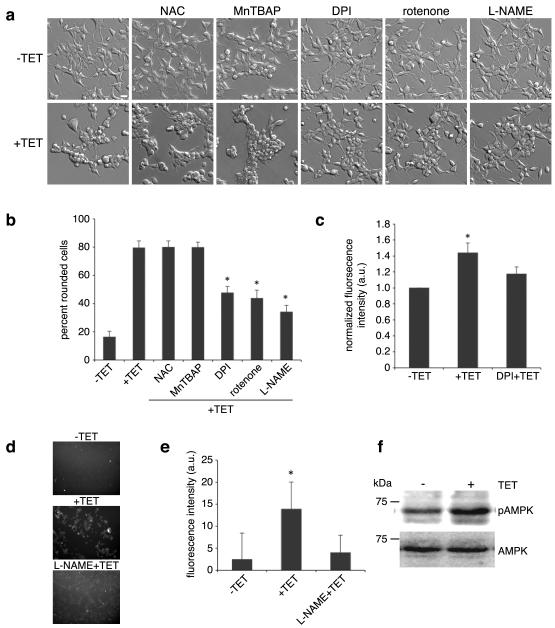Figure 4.
The effects of ROS scavengers or inhibitors of mitochondrial- and NOS-derived free radicals on TRPM7-mediated cell rounding. (a) Application of ROS scavenger NAC (5 μM) and MnTBAP (200 μM) had no effect on the TRPM7-induced cell rounding. In contrast, application of DPI (0.2 μM) and rotenone (10 nM) attenuated cell rounding. Treatment of cells with NOS inhibitor L-NAME (2 mM) also reduced cell rounding. Scale bar is equal to 100 μm. (b) Quantification of the degree of cell rounding under the conditions depicted in (a). An asterisk indicates treatments that produced a decrease in cell rounding that were significantly different from 293-TRPM7 cells grown in tetracycline using χ2 test. (c) Measurement of ROS generation in 293-TRPM7 cells. Overexpression of TRPM7 (+TET) resulted in a modest increase in ROS generation compared to control cells (−TET) that can be reversed with DPI. Average of fluorescence intensity was normalized to control cells (−TET). Values are mean ± standard deviation of three independent experiments. The asterisk indicates a signification difference in fluorescence intensity compare to control cells using a Student t test (p<0.05). (d) Fluorescence emission of 293-TRPM7 cells labeled with the nitric oxide (NO) indicator DAF-FM diacetate. Overexpression of TRPM7 (+TET) resulted in an increase in NO over non-expressing cells (−TET) that can be reversed with L-NAME (2 mM). (e) Quantification of the fluorescence intensity under the condition depicted in (d). Values are mean ± standard deviation of three independent experiments. The asterisk indicates a signification difference in fluorescence intensity compared to the negative control (−TET) using a Student t test (p<0.05). (f) Western blot with an antibody against AMP-dependent kinase (AMPK) and the Thr172-phosphorylated “activated-form” of AMPK indicates that overexpression of TRPM7 increases AMPK activation by 44%. The AMPK experiments were repeated three times with similar results.

